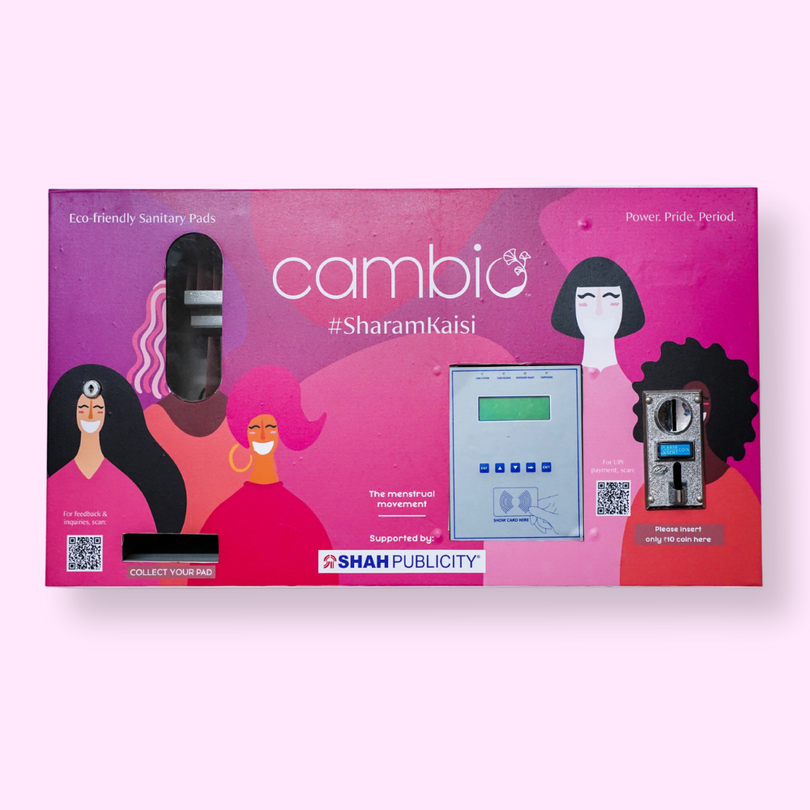Tampons
Tampons Made Simple: FAQs and Facts
A tampon is a small, cylindrical tool that is plugged into your vagina during menstruation. It is mostly made of compressed cotton or a blend of cotton and rayon. It is soft and absorbs the menstrual blood before it can stain you. Tampons come with different absorbency levels, various sizes, and varied applicator types. You can choose them according to your blood flow and comfort level.
Organic tampons are typically made from organic and natural materials to provide an alternative to conventional tampons. While the exact composition can vary between brands, organic tampons generally emphasize the use of natural, biodegradable, and pesticide-free materials. Here are some common components found in organic tampons:
- Organic Cotton: Organic tampons often utilize organic cotton as the primary material for the absorbent core and covering. Organic cotton is grown without the use of synthetic pesticides, herbicides, or genetically modified organisms (GMOs). It is also typically free from chlorine bleach, dyes, and fragrances.
- Biodegradable Materials: In an effort to reduce environmental impact, organic tampons may incorporate biodegradable materials. This can include a biodegradable cardboard or plant-based plastic applicator, if an applicator is used at all. The goal is to make the tampons more eco-friendly and reduce plastic waste.
- Chemical-Free: Organic tampons aim to minimize exposure to potentially harmful chemicals. They are often free from chlorine bleach, dioxins, synthetic fibers, fragrances, and other additives commonly found in conventional tampons.
- Natural Absorbent Fibers: Organic tampons may use a combination of natural absorbent fibers, such as organic cotton, bamboo, or plant cellulose, to enhance absorbency.
Read more: Why use organic cotton tampons?
Tampons are cylindrical rolls of soft cotton or a blend of cotton and rayon. Once they are plugged into your vagina, they expand, and the absorptive quality of cotton takes in all the blood before it can leave your body, giving you hygienic and clean periods.
No menstrual product is better or worse. It's better or worse for You. Hence, the choice of menstrual products is subjective and depends on your comfort, intimate hygiene, and preferences.
Tampons are small cylindrical devices that are inserted into the vagina, whereas menstrual pads are rectangular devices that are stuck on the gusset of your underwear.
To know more about tampons vs pads, read it here.
Any menstruating girl or woman can use tampons. Though it is essential to take several things into account before using a tampon,
- You need to be physically ready to use a tampon.
- Understand basic female reproductive anatomy.
- Analyze whether you are mentally comfortable with using a tampon.
- Gain knowledge about how to use a tampon and all the required dos and don'ts about it.
- Have an adult guide or expert with whom you can talk when in doubt. Our Cambio Woman community is happy to serve you!
The use of tampons is a personal choice, and no one should try using them under any sort of pressure.
Tampon is to be inserted gently into the vagina, from where the period blood comes out.
Tampons come in various sizes and absorbency levels. So here’s how you can assess the right tampon for your period:
- Your flow: People with heavy menstrual flow must go for tampons with high absorbency levels, and vice versa.
- Material: If you have sensitive skin, you may want to stick to tampons that are 100% organic to reduce the risk of rashes, irritation, or infection.
- Applicator: Applicators are devices that help insert the tampon into the vagina. Tampons come with or without applicators. Though for initial users and first-timers, it can come in very handy with the insertion process.
- Your activity level: The choice of your tampon may also vary depending on the amount and type of physical activity you do during the day.
Read more: Which tampon size suits you?
Here is a brief overview of how to insert a tampon:
- 1. Wash your hands thoroughly.
- 2. Unwrap the tampon from its packaging and hold it at the grip or applicator end.
- 3. Find a comfortable position, such as sitting on the toilet or standing with one leg elevated.
- 4. Gently separate the folds of skin around the vaginal opening with your other hand.
- 5. Insert the tampon into the vagina slowly and gently, aiming towards your lower back.
- 6. Use the applicator or your fingers to release the tampon.
- 7. Adjust the tampon if needed for comfort.
- 8. Wash your hands again for hygiene.
Follow the instructions. Start with a small tampon if you are new to this. See your doctor if you experience any discomfort or issues.
Your Cambio Woman is here for you too!
Yes, tampons are safe when used as directed. Keep your hands clean, insert the tampon gently and carefully, and you are good to go!
We recommend changing your tampon after every 4-6 hours. A great way to know if your tampon is full is to try taking it out, and if you feel a pull and find it difficult to remove your tampon, it indicates your tampon is not full yet.
It is highly advised not to leave the tampon on for longer, as it might increase the risk of Toxic Shock Syndrome.
Tampons come in different sizes and absorbency levels. Hence, it can be used for all types of blood flow! All you need to do is get the one most suitable for your flow.
Tampons typically come in different sizes or absorbency levels, which are indicated by the different labeling systems used by different brands. Common sizes or absorbency levels of tampons include:
- Light: They hold up to 3 ml of blood and can be used for light flow.
- Regular: they hold up to 5 ml of blood and can be used for moderate flow.
- Super: They hold up to 11 ml of blood and can be used on days with heavy flow.
- Ultra/Extra Heavy: These are designed for very heavy flow days or those with a heavy flow overnight.
It's important to choose the appropriate size or absorbency level based on your menstrual flow to prevent leakage or discomfort.
Yes, you can sleep with your tampon. The only thing to keep in mind is never keeping your tampon inside for more than 8 hours. So, change your tampon just before going to bed and replace it immediately after waking up.
Always use the right absorbency level to suit your overnight flow.
If you are using a tampon for the first time, you may experience slight discomfort. However, if you choose the correct size and insert the tampon with caution, you will not experience any pain.
If you have chosen the correct size of a tampon, it is unlikely that the tampon will hurt coming out. However, if your pain persists, consult a doctor before using it again.
Plugging and removing a tampon is not painful if done correctly. Though initially, you may feel some discomfort or mild pain (due to stress, tensed muscles, dryness, or sensitivity). But they aren't supposed to hurt after a while or hurt a lot, even during insertion or removal.
Make sure to use the right size and absorbency level of the tampon.
If it hurts you, perhaps stop using tampons for a while or consult a doctor.
No. It is not at all advised to use more than one tampon at a time. Use high absorbency level tampons for heavy flow or a pad/panty liner or a period panty as a precaution against stains.
There is no scientific evidence to suggest tampons induce or increase menstrual cramps. Improper insertion or removal of tampons may result in discomfort or cramps. And even though cramps are part of a person’s menstrual cycle, if you witness increased cramps, do consult your doctor.
First, take a breath and relax. You must calm yourself down because anxiety can make the process much harder.
Next, try to gently find the thread of the tampon and tug at it, bringing it straight out without twisting or tugging forcefully. Use a water-based lubricant or a few drops of water to wet the tampon. Try pulling out the tampon by swatting, over a toilet, or with one leg raised, giving your vagina a comfortable stretch to open up.
Still, if you have no luck, seek medical help!
No, using a tampon doesn’t affect your virginity. ‘Virginity’ is a norm created by society, primarily associated with the sexual intercourse of a person, which is a personal and subjective matter. Using tampons for menstrual hygiene does not impact one’s virginity status.
Yes. If you insert your tampon correctly, it will not absorb any water, and you can easily take a swim. However, we recommend changing your tampon after you indulge in any water or physical activities.
There are three holes down there. One is for you to pee, the other is for your period blood, and the third one is your anus. Your tampon is inserted in the hole where your period blood comes out. So you can easily pee with your tampon inside.
Though the string may get some of the urine. So wash your hands and hold your string safely aside while you pee so it can't stain the pulling thread.
One may feel the tampons during insertion or removal. And even though you may feel the tampons in place after insertion, after a while they're not supposed to feel at all. That’s the beauty of using tampons!
Tampons are one-time-use products made of cotton, rayon, or other synthetic fibers. Though they aren’t specifically biodegradable and contribute to environmental waste. Cambio tampons are made of 100% organic cotton and are nature-friendly.
Tampons create a deposit in your vaginal area, causing a PH imbalance and UTIs. Cambio tampons use Cotton-lock technology, which prevents the shedding of tampon fibres or any risk of infections.
Toxic Shock Syndrome(TSS) is a rare but very serious (possibly fatal) illness that can occur in women, men and children. It is caused by toxin produced by a type of bacteria that is present in humans. TSS can occur without tampons but has been associated with the use of tampons. The common symptoms are vomiting, diarrhoea, dizziness, rash, eye redness, sore throat, weakness, dizziness when standing up, muscular pain. Consult a doctor immediately if you experience any of the symptoms and discontinue the use of tampons until advised by the doctor.
Yes, absolutely! Cambio Tampons are made in an FDA approved facility. They are dermatologically tested for safety and do not contain any harmful that can harm your body. In fact, our tampons are made of 100% Organic Cotton including the absorbent core, the cover and the cord of the tampon. Which means that the cotton that makes these tampons is grown with the highest standards without the use of any pesticides, without being treated with bleach, formaldehyde, or any other toxic substances that can harm your body. However, we suggest that the tampons be changed every 4-8 hours to avoid any infections.
Non-applicator tampons are the same as applicator tampons. However, non-applicator tampons are to be inserted inside the vagina with the force of the finger whereas applicator tampons come with an applicator to help with insertion.
1. If you are not menstruating.
2. If you are hypersensitive to the use of tampons.
3. If you have recently given birth.
4. If you have any vaginal inflammation.
5. If you have had a Toxic Shock Syndrome in the past.
We understand your hesitation to use a new and unknown product. However, tampons are one of the safest ways to manage your period. They are hygienic and easy to use. Make sure you insert a tampon correctly, and you are good to go.
Honestly, your daughter can use a tampon as soon as she gets her first period. We assure you tampons do not affect the virginity of your daughter and are safe and hygienic.
Cambio tampons come in different sizes. For teenagers, we recommend the regular size tampon, which is small and has good absorbency. However, if one experiences medium to heavy flow, one can use super-size tampons.
Tampons can be used by women ageing from 14- 50 years of age. Tampons are entirely safe, hygienic, and comfortable for women of every age group.
Tampons expand inside your vagina to absorb menstrual blood. Therefore, tampons do not dry up your vagina. Change your tampon every 4-6 hours.
TSS is a severe condition caused by bacteria. However, it is rare these days. Nevertheless, it is essential to maintain proper hygiene, like changing your tampon every 4-6 hours. Maintaining adequate hygiene will reduce your risk for TSS.
- Tampons can be tricky and a little uncomfortable to insert or remove.
- When left for a long time, they may increase your chances of developing Toxic Shock Syndrome.
- Disposable tampons add to the menstrual waste.
- It's okay to be apprehensive about new things. Especially about inserting something in your vagina. Read and learn about tampons, watch instructional videos, and talk to a trusted healthcare professional.
- Sit in a comfortable position and take your sweet time with it. Breathe, don't panic, because it will make the process tougher.
- Follow the instructions on the pack.
- You can use water-based lubricants and smooth applicators to make the insertion process smoother.
As rare as it is, tampons, though made to stay in the vagina, may fall out if they aren't inserted properly, you use an inappropriate size and absorbency level tampon.
If such a case happens, just dispose of that tampon and use a new one, securing it in place.
Cambio tampons come with nature-friendly disposable bags to dispose of the used tampons.
Both tampons and menstrual cups are inserted into the vagina, though tampons are cylindrical tubes whereas menstrual cups are bell-shaped devices that can be left inserted into the vagina longer than the tampons.







